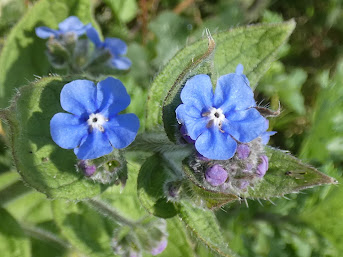Green Alkanet [Pentaglottis sempervirens]
Introduction:
This flower has such lovely deep blue petals one wonders why it is called green alkanet, after all nearly all flowers have green leaves and stems because they contain chlorophyll. The answer would appear to be that this plant retains its green leaves and stems throughout the winter, it is always green even when there are no blue flowers.
Green alkanet is native to south western Europe but, as a hardy perennial, it has established itself in various parts of the world, adding a splash of colour. It is also a popular plant in gardens which has encouraged its spread.
Description
Green Alkanet has lush green leaves and striking blue flowers. The scientific name "Pentaglottis sempervirens" hints at its evergreen nature, as the plant retains its leaves throughout the year.
The plant typically reaches a height of 30 to 60 centimetres, forming a dense rosette of large, hairy leaves. The lance-shaped leaves are deep green and covered with stiff hairs, giving them a rough texture. One of the distinctive features of green alkanet is its intense blue flowers, which appear in clusters at the tips of the stems
It belongs to the borage family (Boraginaceae) and is related to forget-me-nots as can clearly be seen in the shape of the flowers.
The flowers can be seen from as early as March through until July.
Habitat
Green alkanet can be found on roadsides and in hedgerows, sometimes in woodland borders, and often this will be near human habitation. Although a native plant it was often grown in cottage gardens and has frequently escaped.
It does not grow on acid soils preferring more alkaline conditions and it is thought that is where the alkanet name comes from. There are other varieties of alkanet grown in gardens and they too are sometimes encountered in the wild.
Locally
To date (December 2023) I have found green alkanet on nine monitored sites within the Sidmouth area and has also been encountered in various other places in the town. It is certainly not an uncommon plant in this area.
There are records from April through until June but May would certainly seem the best time to see it.
You can see more detail about local records here
Significance
While green alkanet is primarily recognized for its ornamental value in gardens, it has historical significance in traditional medicine. The plant has been used for its purported diuretic and anti-inflammatory properties.
In folk medicine, green alkanet was employed to treat various ailments, including skin conditions and respiratory issues. However, it's important to note that the medicinal uses of green alkanet are not widely supported by scientific evidence.
The plant was also used for dyes. The roots of the plant contain a compound called alkanet oil (alkannin) which has been used to produce a range of shades, from deep purple to vibrant red. This dye was traditionally used to colour textiles, cosmetics, and even food.
Benefits
Beyond its aesthetic appeal, green alkanet plays a crucial role in the ecosystem. Its flowers provide a vital source of nectar for pollinators, supporting the health of local bee populations. Additionally, the plant's robust nature makes it an excellent ground cover, helping prevent soil erosion and contributing to the overall stability of the environment.
Conclusion
Green alkanet stands out as a resilient and captivating plant. From its vibrant blue flowers to its ecological contributions, this herbaceous perennial has much to offer. Whether admired for its ornamental beauty in gardens or recognized for its role in supporting local biodiversity, green alkanet is a testament to the diversity and wonder of the natural world.



Comments
Post a Comment